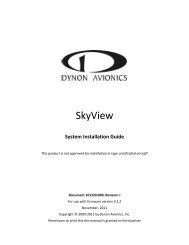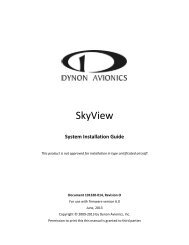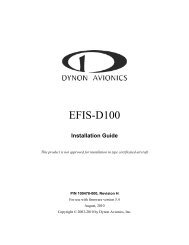EFIS-D60 Installation Guide - Dynon Avionics
EFIS-D60 Installation Guide - Dynon Avionics
EFIS-D60 Installation Guide - Dynon Avionics
Create successful ePaper yourself
Turn your PDF publications into a flip-book with our unique Google optimized e-Paper software.
Appendixcontroller. Remember that even when the controller is powered on, it only heats the probe theamount necessary to maintain temperature.The black wire should be permanently connected to ground. Cutting power to the heatercontroller should occur via the red power line, not the black ground line.Heater Status ConnectionNote: The probe heater functions properly whether or not you make this connection. It is simplya status output for your convenience.The white heater status wire is grounded when the probe heater is turned off or not functioningproperly. This wire should be connected to a light on the panel, whose other terminal isconnected to switched aircraft power. When the heater is on and functioning properly, the whiteheater status line is open, leaving the indicator light turned off. When there is no power to theheater controller – or it is not functioning properly – the white line is grounded, turning theindicator light on.Aircraft Spruce P/N 17-410 is an example of a light that will work for this application. An LEDand resistor in series will also suffice. If you use an LED as the indicator, you must choose aresistor that delivers the appropriate current to the LED, and can accommodate the powerrequired for its current and voltage drop.If you own a <strong>Dynon</strong> EMS-based product, you may also use one of its two contact input todisplay an onscreen indication. Connect this heater status output directly to the desired EMScontact input, with no additional resistors or lights. You must configure the contact display asdescribed in your EMS-based product’s <strong>Installation</strong> <strong>Guide</strong>.AOA/PITOT PROBE MOUNTINGThe <strong>Dynon</strong> <strong>Avionics</strong> AOA/Pitot probe has been designed as an under-wing pitot. The followinginformation applies to this type of installation. If you wish to mount your pitot on nose boommount, contact us so we can make the appropriate adjustments to your pitot. The heated versionof <strong>Dynon</strong>’s AOA/Pitot Probe does not come in a boom-mount configuration.AOA/Pitot Probe Mount LocationThe <strong>Dynon</strong> <strong>Avionics</strong> AOA/Pitot probe only functions correctly when mounted in a locationwhere the airflow over the probe is relatively undisturbed by the aircraft. In general, werecommend that you mount it at least 6 inches below the wing and with the tip of the probebetween 2 and 12 inches behind the leading edge of the wing. Typically, pitot probes aremounted about mid-wing span wise to minimize the effects of both the propeller and the wingtips. Testing during the probe development has shown that the standard mounting locations forthe pitot probe in the RV series of aircraft also works for the <strong>Dynon</strong> probe.AOA/Pitot Probe Mounting InstructionsAfter the mounting location has been determined, mount the pitot mounting kit per the includedinstructions or fabricate your own mount. In either case, mount the probe securely to the wingsuch that the body of the probe is horizontal during level flight. Drill and tap mounting holes (#6-32) on the probe to match your mounting bracket. Use caution when drilling the holes, ensuringthat you avoid drilling into the pitot and AOA pressure lines. As long as you do not penetrate<strong>EFIS</strong>-<strong>D60</strong> <strong>Installation</strong> <strong>Guide</strong> 5-11
















